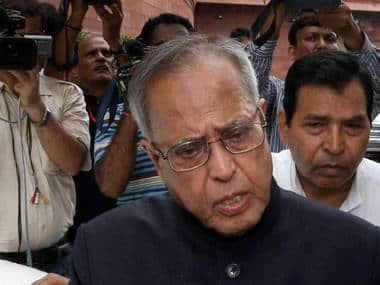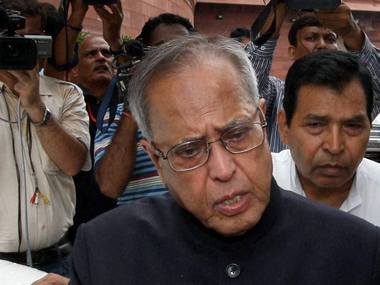The art of economic management follows certain karmic rules. If you’ve been prudent in difficult times, living within your means and perhaps even tightening your belt to put aside some savings, there’s a fair chance that you will have some fuel left over in your tank when you need to get your economic engines vrooming again.
But if you’ve been living way beyond your means and bingeing on borrowed money, and every one of your ill-conceived welfare policy initiatives is aimed at ensuring a smooth dynastic succession by throwing money around at voters and special interest groups, well, you’ll only have a colossal hangover - and an empty khazana - when you desperately need to jump-start the engine.
The UPA-2 government today finds itself confronting just such a karmic predicament. Just when it needs to pull out the big guns to get the slowing economy booming again, it finds that its weapons have become rusty from disuse and it is low on ammunition - because it went trigger-happy with its reckless spending over the past two years.
[caption id=“attachment_198663” align=“alignleft” width=“380” caption=“Just when the government needs to pull out the big guns to get the slowing economy booming again, it finds that its weapons have become rusty from disuse and it is low on ammunition - because it went trigger-happy with its reckless spending over the past two years. Vijay Kumar Joshi/PTI”]
 [/caption]
[/caption]
Forced on the defensive by monstrous corruption scandals within the ruling coalition right from early on in its second innings, it’s been frozen into policy inaction. Living in mortal fear of, first, a middle-class uprising against corruption, and then, of its allies, each more recalcitrant and temperamental than the other, and finally of its own shadow, it has postponed policy initiatives and reforms - and been blind to the very real problems confronting the economy.
When inflation raged at close to double digits for much of last year, despite the muscular exertions of the RBI, which had the effect of slowing down growth, UPA-2’s All-Star Team of economic managers offered nothing more than pious platitudes that things will get better.
With the result that even today, thanks to a rupee that went into free fall in the last quarter of 2011 and widening deficits all around, inflation hasn’t been well and truly vanquished. This constrains the RBI from undertaking any easing of interest rates - for fear of stoking inflation and undoing all the work it single-handedly did.
But the government’s problems run far deeper than that. Given that it has slipped on so many fronts simultaneously, it faces a perfect storm of rank-bad macroeconomic failings on a variety of parameters, which leaves it with no room to hide.
The government’s alibi thus far has been that most of the economic stresses that India faces are a consequence of a global economic slowdown, arising principally from the eurozone crisis. That is an overstatement that overlooks the government’s own fiscal profligacy and its inertness in responding to these crises.
Sure, there is half a truth in that claim: the eurozone crisis did compound problems, not just for India, but for a whole lot of other emerging economies too. But when you compare India’s standing even among the universe of emerging economies, as the Economist did recently , it shows up the Indian economy as being particularly lacking in elbow room to implement pro-growth policies because of the sins of the past.
On virtually every one of the parameters on which 27 emerging markets were assessed, India figures pretty much at the bottom of the ladder. To the extent that other emerging economies have fared relatively better, this effectively nails the government’s alibi - that this is an “imported crisis”. But more significantly, it means that Pranab Mukherjee and his merry band of policymakers don’t have “wiggle room” - in terms of fiscal and monetary firepower - to get the economy humming again.
On the magazine’s overall ‘Wiggle Room Index’, which is a measure of the room that each country has to ease fiscal and monetary policy, India figures 26th on the list of 27 economies. “India’s Achilles Heel is an overly lax fiscal policy and an uncomfortably high rate of inflation,” it says.
On each of the sub-parameters that make up the index, India again scores poorly. Consumer price inflation may have eased but is still untamed; real interest rates are less than 1 percent, which means there isn’t enough room to lower rates without throwing savers to the vagaries of inflation; the rupee has depreciated in excess of 10 percent (even after the recent rebound), which renders the country susceptible to imported inflation; India’s current account deficit is among the worst of the 27 economies, which again leaves it vulnerable if global financial conditions tighten; its fiscal flexibility, which is a measure of government debt and cyclically adjusted budget deficit as a percentage of GDP, is only worse than Egypt’s owing to fiscal profligacy of the past, which cramps it from responding to another downturn; and its debt is among the highest in this emerging market universe.
All this means Pranab-da’s hands are virtually tied in terms of his capacity to revive the economy. The government’s balance-sheet is about as red as it can get.
To be fair, some of the other pillars that hold up the economy, including households, corporates and financial institutions, are fairly strong, even when compared to other economies.
But until the government gets its act together, by performing some purificatory ritual that absolves it of its previous sins of profligacy, it is bound to be haunted by the law of karma.
Venky Vembu attained his first Fifteen Minutes of Fame in 1984, on the threshold of his career, when paparazzi pictures of him with Maneka Gandhi were splashed in the world media under the mischievous tag ‘International Affairs’. But that’s a story he’s saving up for his memoirs… Over 25 years, Venky worked in The Indian Express, Frontline newsmagazine, Outlook Money and DNA, before joining FirstPost ahead of its launch. Additionally, he has been published, at various times, in, among other publications, The Times of India, Hindustan Times, Outlook, and Outlook Traveller.
)